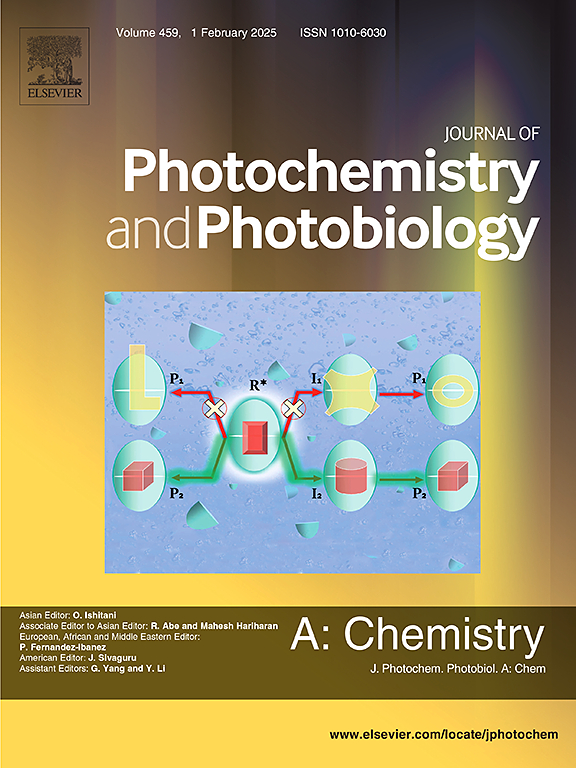氧化铝/聚乙烯吡咯烷酮纳米纤维增强纳米复合材料对木材脱木质素和渗透的光致发光智能窗口用于紫外线辐射的检测和过滤
IF 4.1
3区 化学
Q2 CHEMISTRY, PHYSICAL
Journal of Photochemistry and Photobiology A-chemistry
Pub Date : 2025-04-22
DOI:10.1016/j.jphotochem.2025.116456
引用次数: 0
摘要
研制了一种在紫外线照射下可变色的新型光致发光硬木。将电纺丝氧化铝/聚乙烯吡咯烷酮纳米纤维增强聚苯乙烯纳米复合材料和稀土铝酸盐(REA)的混合物渗透到去木素化硬木中,制备了具有余辉和光致变色性能的透明木模板。该REA颜料具有优异的热稳定性和光稳定性。在氧化铝纳米纤维增强预聚合聚苯乙烯中分散REA纳米颜料的同时避免颜料纳米粒子的聚集,对于开发透明光致发光木材具有重要意义。光致发光光谱和比色数据表明,在紫外光照射下,透明木材呈现绿色。REA颜料采用固相法合成,而REA纳米粉体采用自顶向下技术制备。采用溶胶-凝胶法制备了聚乙烯吡咯烷酮/氯化铝的可纺溶液。然后对EAN进行煅烧,得到直径为50-200 nm的氧化铝纤维。纳米颜料的直径为8 ~ 15 nm。在375 nm激发下发光的透明木材在518 nm处显示出强烈的发射峰。随着荧光粉浓度的增加,其耐水性和防紫外线性能均有所提高。本文章由计算机程序翻译,如有差异,请以英文原文为准。

Delignification of wood and infiltration with alumina/polyvinylpyrrolidone nanofiber-reinforced nanocomposite toward photoluminescent smart window for detection and filtration of ultraviolet radiation
Novel photoluminescent hardwood that can change color under ultraviolet illumination was developed. Transparent wood templates with afterglow and photochromic properties were developed by infiltrating a mixture of electrospun alumina/polyvinylpyrrolidone nanofiber-reinforced polystyrene nanocomposite and rare-earth aluminate (REA) into a delignified hardwood. The REA pigment has excellent thermal stability and photostability. Avoiding aggregation of the pigment nanoparticles (NPs) while dispersing the REA nanopigment in an alumina nanofiber-reinforced pre-polymerized polystyrene is significant for the development of a transparent photoluminescent wood. The photoluminescence spectra and colorimetric data showed that the transparent wood switches to green under UV illumination. The REA pigment was synthesized by the solid-state method, whereas the REA nanopowder was developed by the top-down technology. A spinnable solution of polyvinylpyrrolidone/aluminum chloride was developed by the sol–gel method. EAN was then calcinated to provide alumina fibers with diameters of 50–200 nm. The pigment nanoparticles displayed diameters of 8–15 nm. The transparent wood that emitted light upon excitation at 375 nm displayed a strong emission peak at 518 nm. Improved water resistance and UV protection were observed with increasing the phosphor concentration.
求助全文
通过发布文献求助,成功后即可免费获取论文全文。
去求助
来源期刊
CiteScore
7.90
自引率
7.00%
发文量
580
审稿时长
48 days
期刊介绍:
JPPA publishes the results of fundamental studies on all aspects of chemical phenomena induced by interactions between light and molecules/matter of all kinds.
All systems capable of being described at the molecular or integrated multimolecular level are appropriate for the journal. This includes all molecular chemical species as well as biomolecular, supramolecular, polymer and other macromolecular systems, as well as solid state photochemistry. In addition, the journal publishes studies of semiconductor and other photoactive organic and inorganic materials, photocatalysis (organic, inorganic, supramolecular and superconductor).
The scope includes condensed and gas phase photochemistry, as well as synchrotron radiation chemistry. A broad range of processes and techniques in photochemistry are covered such as light induced energy, electron and proton transfer; nonlinear photochemical behavior; mechanistic investigation of photochemical reactions and identification of the products of photochemical reactions; quantum yield determinations and measurements of rate constants for primary and secondary photochemical processes; steady-state and time-resolved emission, ultrafast spectroscopic methods, single molecule spectroscopy, time resolved X-ray diffraction, luminescence microscopy, and scattering spectroscopy applied to photochemistry. Papers in emerging and applied areas such as luminescent sensors, electroluminescence, solar energy conversion, atmospheric photochemistry, environmental remediation, and related photocatalytic chemistry are also welcome.

 求助内容:
求助内容: 应助结果提醒方式:
应助结果提醒方式:


